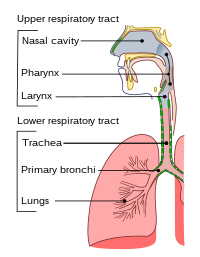
Photo from wikipedia
We read with great interest the recent article by Fiorella et al in which the authors discussed several practical points on neurointerventional management of large vessel occlusion (LVO) acute ischemic… Click to show full abstract
We read with great interest the recent article by Fiorella et al in which the authors discussed several practical points on neurointerventional management of large vessel occlusion (LVO) acute ischemic stroke (AIS) during the coronavirus 2019 (COVID-19) pandemic. Although we fully agree with Fiorella et al about considering aggressive measures in triaging during the endovascular treatment (EVT) of AIS patients in order to minimize severe acute respiratory syndrome coronavirus 2 (SARSCoV-2) infection exposure and transmission to healthcare personnel (HCP), we are urging a more cautious and balanced approach. While EVT is one of the most effective treatment in the management of LVO strokes, its impact is optimized if it is performed in a timely manner. It has been speculated that every 30min delay from symptom onset to reperfusion (OTR) of the occluded vessel translates into a decrease in good functional outcome by 12%–21%. 4 OTR time constitutes a combination of onset of stroke symptom to groin/arm puncture (OTP) and puncturetorecanalization times. Ota et al have demonstrated the independent impact of OTP time on the functional outcomes of the patients undergoing EVT. Cerebrovascular complications have been reported in patients with severe COVID-19. Although patients with known SARSCoV-2 infection who develop AIS make up a small proportion of AIS patients, 11 there is a larger group of asymptomatic carriers or patients with COVID-19 nonneurological symptoms who present with AIS and are diagnosed with SARSCoV-2 infection during the emergency department (ED) evaluation. As such, we agree with Qureshi et al that all AIS patients should be assumed to be positive for the infection on arrival to the ED. In the ED, appropriate and immediate screening for SARSCoV-2 infection may not be feasible in a group of AIS patients particularly in the setting of LVO due to lack of availability of informative family or friends, lack of available SARSCoV-2 rapid tests, and the timeconsuming nature of other laboratory assessments. As a result, strategies to reduce the exposure of HCP who are engaged in the management of AIS to the patients with unknown rapid test result while keeping the OTR for EVT to the least possible time is of utmost importance. Endotracheal intubation prior to EVT of suspected or confirmed SARSCoV-2infected patients has been recommended as one of the precautionary measures to protect HCP. The impact of this approach on patients’ outcomes was evaluated in a recent multiinstitutional prospective study by Kasab et al of 458 patients from 28 North American centers. The authors reported significantly longer door to reperfusion time, higher inhospital mortality, and lower likelihood of functional independence at discharge in patients who underwent intubation prior to EVT. Furthermore, two other studies by Taqi et al and Settecase et al, investigated the impact of sedation modes on timing and the delay in reperfusion, and showed better functional outcome in patients who underwent conscious sedation compared with general anesthesia. This impact was attributed to shorter OTP times. While preprocedural intubation has been shown to have a negative impact on patients’ functional outcomes due to delaying the EVT, intubation itself is considered a highrisk procedure in terms of potential SARSCoV-2 exposure and transmission caused by close contact with the patient’s airway before, during and after the procedure. Taking into consideration the concerns of stroke centers in terms of scarcity of resources during the pandemic, 17 we propose an algorithm in which suspected or confirmed SARSCoV2infected patients are categorized based on their individual risk factors in order to make a reasonable decision as to whether they require preprocedural intubation. Risk factors include: diagnosis of LVO in the posterior circulation, severe stroke (National Institutes of Health Stroke Scale (NIHSS) score on admission >15) or Glasgow Coma Scale (GCS) <9, inability to follow commands due to aphasia, acute respiratory distress/hypoxemia (drop of O2 saturation by pulse oximetry (SpO2) <95%) or any signs of dyspnea (gasping, sweating, tachycardia, use of auxiliary respiratory muscles), persisting systolic blood pressure >180 mmHg and/or endtidal CO2 >45 mmHg, active cough, active vomiting, severe agitation and seizures. 18–20 For patients with any of the abovementioned risk factors, endotracheal intubation should be performed in a negativepressure room by an airway specialist with videoguided laryngoscopy and consideration of all precautionary measures before arrival to the angiography suite. Mitigating intubationassociated complications, particularly hypotension which is more common in SARSCoV2infected patients, by using sympathomimetics and prescribing ketamine or etomidate to maintain cerebral perfusion pressure, are additional points that should be considered. The authors believe that proceeding with EVT using conscious sedation in a selected group of patients and those without the abovementioned risk factors should be highly considered. This practice would ideally avoid further delay of the EVT in these patients and improve the longterm functional outcome, while limiting the exposure of HCP to SARSCoV-2 infection.
Journal Title: Journal of NeuroInterventional Surgery
Year Published: 2021
Link to full text (if available)
Share on Social Media: Sign Up to like & get
recommendations!